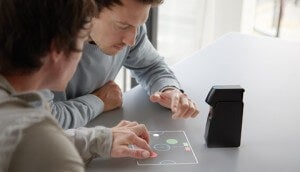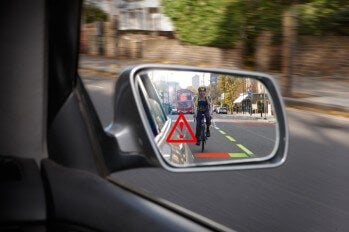
How many hours a day do you spend staring at a flat surface? You probably don’t think of it that way, but TVs, computer screens, mobile phone displays – these are just boring flat surfaces until we place images on them. So why not forget those devices and keep the images? Light Blue Optics (LBO) is using holographic laser projectors to transform ordinary surfaces into interactive displays. Their Light Touch device projects a 10.1 inch screen and uses an IR light and camera to track finger position in that area. LBO recently announced at CES that it is working with Microsoft, Adobe, Toshiba and other partners to support Light Touch with their products. CES also named the device an as innovation honoree for the year. Check out a brief demo of Light Touch at CES in the video from BBCBlueRoom after the break.
We’ve seen various technologies looking to exploit the advantages of turning surfaces into interactive media. Projects like the mammoth RingWall are stationary and excel as multi-user interfaces. Pranav Mistry’s SixthSense device is highly portable and uses gestures to control data that is projected onto walls, newspapers or even hands. Light Touch is somewhere between these two extremes. It is small enough to be incorporated into spaces not traditionally dedicated to video interfaces, yet it is robust enough to handle multiple users and high quality video. The software and hardware it will interact with isn’t well defined yet. It can play videos and games off a stored memory, but it can also connect with computers, mobile phones, and other devices. The Light Touch could function as an attachable pico projector, I guess.
The Light Touch has some obvious limitations when it comes to luminosity. CES is in a well lit auditorium, and the display isn’t always bright enough to be clear to the video recording camera. That’s a common problem with small scale projectors that we’ve seen in the past. Of course, Light Touch does have the advantage of using laser technology, helping it maintain focus at any distance and on a curved surface. LBO is very proud of its version of holographic laser projection (HLP) which uses diffraction to produce images. The following video explains:
Go into many malls, airports, or museums these days and you’ll find interactive touchscreens incorporated into information kiosks. They’ve become something of a ubiquitous tool for guiding people how to use public spaces. I can see the Light Touch taking over that market almost entirely. While touchscreens do offer brighter displays, they also take up more space can be easily damaged by the repeated banging of anxious hands and fingers. The surface on Light Touch can never wear out and the delicate parts of the device can be secluded out of line of sight.

LBO and its HLP technology may also have an important role to play in automotive innovation. Their Light Speed projector system places important dials and warnings directly on the windshield or side view mirror to help drivers avoid accidents. It was integrated as part of the MINI concept car at the Paris Motor Show in 2008.
Despite these powerful niche markets that LBO could fill, however, I’m not sure if I prefer their device over related solutions. The SixthSense system does more and it will be open source, allowing for a wide number of applications to be created for it quickly. Tablet computers will provide mobility and versatility even if they are tied down to a single surface. In short, I think that the Light Touch is an amazing device, but I don’t think we’ll all have one. They’ll be incorporated into public spaces, maybe our cars, and that’s definitely cool. Projected touch screens are an important step in “waking up” our environment by incorporated digital information into it. Someday, of course, flat surfaces won’t just have computer images projected onto them, they’ll actually be made of computers. And I’ll probably still spend most of my day staring at them.
[photo credit: Light Blue Optics]


